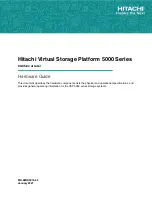
Multipath architecture
The multipath architecture feature of the TS4500 tape library allows Open Systems
applications to share the robotics of the library.
The TS4500 tape library features storage area network (SAN) ready multipath
architecture. This architecture allows homogeneous or heterogeneous Open
Systems applications to share the library's robotics without middleware or a
dedicated server (host) acting as a library manager. The SAN-ready multipath
architecture makes sharing possible by partitioning the library's storage slots and
tape drives into logical libraries. Servers can then run separate applications for
each logical library. This partitioning capability extends the potential centralization
of storage that the SAN enables. Partitioning also provides investment protection if
your application does not support the mixing of drive generations and media in
the same logical library.
The multipath architecture of the TS4500 tape library is designed to provide the
capability to share the library robotics. The sharing is accomplished first by
partitioning the library into as many as 192 logical libraries (up to the number of
drives installed). Then, each logical library is assigned its own separate and
distinct drives, storage slots, and control paths. Input/output (I/O) slots are shared
on a first-come-first-serve basis. This type of partitioning is designed to allow
heterogeneous applications to share the library robotics independent of each other.
Cartridges under library control are not shared between logical libraries, nor are
they allowed to be moved between logical libraries. An example of heterogeneous
sharing is a Microsoft Windows application that is using the drive and storage
slots of one logical library, while a UNIX application uses the drive and slots of
another logical library. Logical libraries can also be used for separating LTO 5 tape
drives and cartridges from LTO 6, LTO 7, LTO 8, or 3592 tape drives and
cartridges, for applications that do not support mixing the drives in the same
logical library.
Whether partitioned or not, the TS4500 tape library is certified for SAN solutions
(such as LAN-free backup).
The multipath architecture allows for more than one control path to be configured
for any one logical library. A control path is a logical path into the library through
which a server sends standard SCSI Medium Changer commands to control the
logical library. Multiple control paths reduce the possibility of a failure in one
control path to cause the entire library to become unavailable. Use of the control
path failover feature further reduces that possibility.
Multiple logical libraries
The TS4500 tape library supports multiple libraries to share the physical library
between applications, or to support mixed drive types for any application.
You can create multiple logical libraries by partitioning the library’s tape drives
and tape cartridges into two or more logical libraries. Each logical library consists
of:
v
Tape drives
v
Tape cartridges in storage slots
v
Tape cartridges in input/output (I/O) slots
Each logical library has its own control path. A control path is a logical path into
the library through which a server sends standard SCSI Medium Changer
42
IBM TS4500: Introduction and Planning Guide
Summary of Contents for TS4500
Page 1: ...IBM TS4500 Introduction and Planning Guide EC SC27 5990 06 IBM...
Page 4: ...iv IBM TS4500 Introduction and Planning Guide...
Page 8: ...viii IBM TS4500 Introduction and Planning Guide...
Page 10: ...x IBM TS4500 Introduction and Planning Guide...
Page 12: ...xii IBM TS4500 Introduction and Planning Guide...
Page 49: ...2 and 4 Figure 9 B accessor in Service Bay B Chapter 1 Overview 31...
Page 88: ...70 IBM TS4500 Introduction and Planning Guide...
Page 99: ...Figure 17 Access panel for Fibre Channel and Ethernet cable routing Chapter 2 Planning 81...
Page 186: ...Korea Notice Russia Notice 168 IBM TS4500 Introduction and Planning Guide...
Page 217: ......
Page 218: ...IBM Printed in USA...
















































